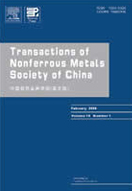Corrosion and wear properties of micro-arc oxidation treated Ti6Al4V alloy prepared by selective electron beam melting
(1. School of Materials Science and Engineering, Xi’an University of Technology, Xi’an 710048, China;
2. School of Metallurgical and Engineering, Xi’an University of Architecture and Technology, Xi’an 710055, China;
3. State Key Laboratory of Porous Metal Materials, Northwest Institute for Non-ferrous Metal Research, Xi’an 710016, China)
2. School of Metallurgical and Engineering, Xi’an University of Architecture and Technology, Xi’an 710055, China;
3. State Key Laboratory of Porous Metal Materials, Northwest Institute for Non-ferrous Metal Research, Xi’an 710016, China)
Abstract: In order to analyze the effect of voltage during micro-arc oxidation (MAO) on corrosion and wear properties of Ti6Al4V (TC4), the MAO technology was employed to treat TC4 samples fabricated by selective electron beam melting (SEBM) at the voltages of 400, 420 and 450 V. The results show that the metastable anatase phase gradually transforms to rutile phase with oxidation time and temperature increasing. The surface morphology of coating contains numerous micropores with uniform size distribution. Cracks and pores over 10 μm are found on MAO-TC4 sample with applied voltage of 450 V. The thickness of MAO coating is positively correlated with the voltage. The corrosion resistance and wear resistance are related to phase composition, micropore size distribution on the surface and film thickness. When the voltage is 420 V, the coating shows the smallest corrosion current density (0.960×10-7 A/cm2) and the largest resistance (7.17×105 Ω·cm2). Under the same load condition, the coating exhibits larger friction coefficient and wear loss than the TC4 substrate. With the increase of voltage, the wear mechanism of the coating changes from abrasive wear to adhesive wear, and the adhesive wear is intensified at applied voltage of 450 V, with a maximum friction coefficient of 0.821.
Key words: selective electron beam melting; micro-arc oxidation; TC4 alloy; corrosion; wear property

